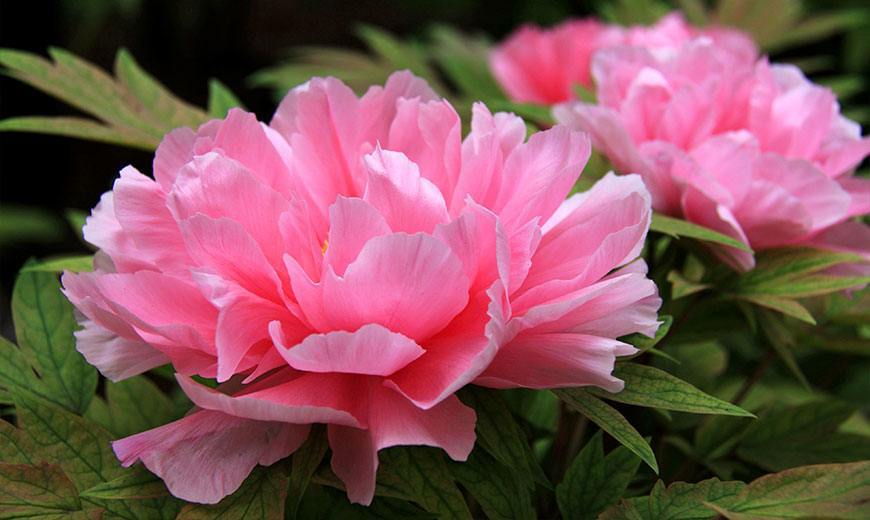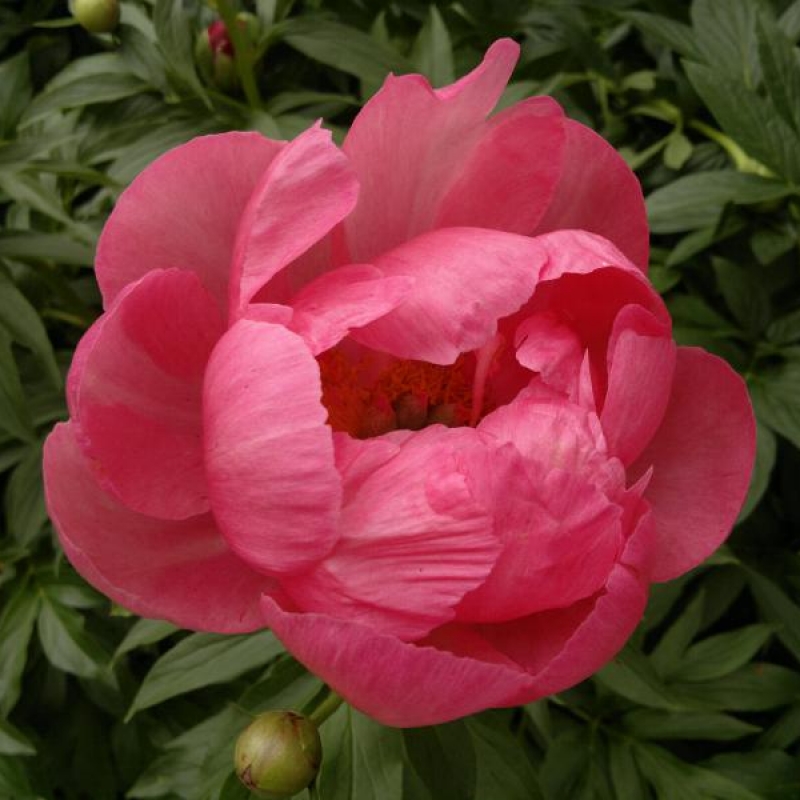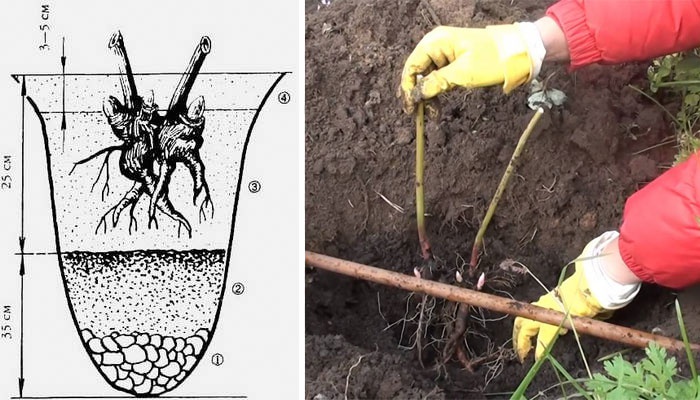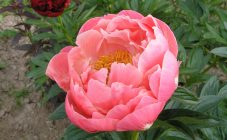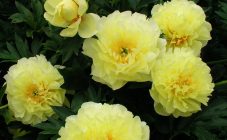Content:
Milk-flowered peony is a unique plant, which is famous not only for its decorative, but also medicinal qualities.
This species was introduced to England in the 1700s and quickly became famous around the world. In nature, it is widespread in China, Japan, Mongolia, Korea and Russia.
It is in China and Japan that it is used mainly for medicinal purposes. The active ingredient of the plant is pionoflorin. It can help reduce fever, relieve pain, and even stop bleeding. Decoctions of the rhizome of this plant also help with bronchitis, tuberculosis and pneumonia.
Features of appearance
Peony is a perennial herb with a height of 60 to 100 cm. The stem of the plant is bare and has 1 or more flowers. Peony leaves are dvazhdytroychatye, have an elliptical or lanceolate shape. Mostly there is a white or red shade of a flower, the length of the petals of which reaches about 8 cm.
Each plant has from 3 to 6 fruits, which are oval and black in color. The peony blooms in May, and its seeds ripen in October.
Variety of peony varieties
This culture is simply replete with a variety of varieties. The most popular among them are:
- Peony Kansas - famous for its large flowers, the diameter of which reaches about 20 cm. The color of the flower is deep red with a raspberry-lilac shade. It has a delicate and pleasant scent. The height of the Kansas peony reaches 90 cm. Its advantage is that it stands cut for a long time in the water.
- The Miss America peony has semi-double flowers, the diameter of which reaches 25 cm.The color of the flower is initially white, and when it blooms, it acquires a pink tint. Miss America has a very light aroma. In 1956 and 1971 this variety received the Gold Medal from the American Peony Society.
- Peony Red Charm has won the hearts of many growers for its lush flowers and dense foliage. Translated from English, Red Charm means "red charm". The height of the bush reaches 75 cm, and the diameter of the flower reaches 20 cm. Blooming in its 3 year of life is of particular admiration.
- Peony Duchesse de Nemours is one of the oldest varieties to have a white tint. It is this species that has remained the standard by which other varieties are judged for many years. Peony received an award from the Royal Horticultural Society of England.
- Peony Raspberry Sunday saw the world thanks to Dutch scientists. Most of all, the color of the flowers of this plant is striking: it harmoniously combines white, yellow and pink shades. Also, this variety has a strong and pleasant aroma.
- Peony Sarah Bernard Red got its name from Pierre Lemoine. The breeder named the flower after the famous actress Sarah Bernhardt at the time, who, in his opinion, was as refined and sophisticated as this peony. A characteristic feature of the variety is its high frost resistance and a variety of colors. Milk-flowered peony Red Sarah Bernardt has not only a red hue: there are also plants of this variety, which have white, yellow and cream colors. Also, Bernard's peculiarity lies in the fact that he begins to turn green in April and retains its decorative effect until autumn.
- Peony Sylvia Sanders cannot boast of a noble scent, as it is very weak and indefinite. But Silvia has a pure pink delicate color, from which it is simply impossible to take your eyes off.
Peony Shirley Temple: description
Shirley Temple peony is quite interesting from a decorative point of view. This plant was widely used in the landscape as early as the 16th century. White or pale pink shades of this variety look harmonious with many plants. However, although the flower tolerates the neighborhood, it does not like too close plantings. Shirley's advantage is that it can have more than 3 flowers on 1 stem.
The variety is not afraid of frost and drought, and is also very resistant to gray mold.
Features of planting and crop care
In order for a peony to develop well and delight with its excellent flowers, it is necessary to properly care for it.
It all starts with the landing. The plant is planted in the fall. To do this, a month before disembarkation, a place is selected and the soil is prepared.
A landing hole is dug 60 × 60 × 60 cm in size. Its 2/3 parts are filled in equal quantities with a mixture of sand, humus and garden soil. They add 500 g of bone meal, 1 tbsp. l. ferrous sulfate and a liter of wood ash. To fill the remaining space, you need to fill up with ordinary earth.
In the first year after planting, the peony will not bloom and will only have 1 or 2 stems. Do not be alarmed if the plant does not bloom in the second year. The main thing is that it should be more developed than in the first year of life. At this point, the peony should have 3 to 6 stems.
Young plants need foliar feeding, which begins in the second week of May. Repeat it once a month. Mineral fertilizers are well suited for this. For example, you can use the Ideal tool. In order for the peony to absorb the fertilizing well, you can add a little soap to it.
If the plant is already adult, then it needs feeding at the beginning of the growing season. They are introduced starting from the 2nd week of May with an interval of 3 weeks. Each stage is distinguished by the type of fertilization:
- 50 g of urea is diluted in 10 liters of water.
- To 10 l of urea solution add 1 tablet of micronutrient fertilizer.
- 2 tablets of micronutrient fertilizer are dissolved in 10 liters of water.
You need to water the plants infrequently, but it is good - about 2-3 buckets per bush so that the water reaches the roots well. Peonies especially need moisture in spring and during flowering.
Varieties of peony lactobacillus can remain profusely flowering for about 30 years, and some species can live for 100 years.
In the fall, before the onset of frost, the plant is cut under the soil level and sprinkled with ash.
Usually, peonies are propagated by dividing and by seeds.
You can divide a plant that has lived for at least 4 years. It should already have at least 7 stems and a well-developed root system.
As for the seeds, they are sown in moist soil in August. It is better to use freshly harvested seeds, then they will germinate in the first year.
Major diseases and pests of culture
Most often, milk-flowered peonies are affected by viral and fungal infections. Such diseases are mainly caused by weather conditions. For example, gray rot develops rapidly in spring and summer with wet and rainy weather. If it is warm and humid outside, rust may appear. However, the disease is not only caused by weather conditions. So, fungal diseases can also occur due to soil oversaturated with nitrogen or due to excessive shading of the site.
Diseases:
- The most dangerous is gray rot, since it affects all parts of the plant. At an early stage, the disease can be detected in the spring, when the peony begins to wilt. Over time, the culture will be covered with gray areas, and a brown color will appear around the root collar.If the plant is not treated, then it can rot and die. To prevent the appearance of gray rot, it is necessary to regularly loosen the soil, avoid thickening of the plantings and do not abuse excessive watering of the soil. If the infection has already occurred, then you can use a tool such as Photosporin-M.
- Rust appears on the plant in the form of brown spots. This disease causes the leaves to die, and if left untreated, other parts of it may suffer. Over time, the peony may even die, since photosynthesis and metabolism are disrupted in an infected flower, and it also quickly loses moisture. You can fight this disease with the help of products that include sulfur. Good helpers in this matter are Abiga-Peak, Cumulus, Poliram, Strobi.
- The spot is caused by microscopic fungi, or viral particles. But most often the appearance of this disease is caused by small worms called nematodes. In the early stages, the disease is difficult to identify, and when it is already progressing, it does not respond well to treatment and often leads the plant to death. To combat the disease, use Gamair or Photosporin-M.
Also, peonies can attack a variety of ants, beetles and caterpillars. To get rid of them, you should treat the plant with a drug such as Iskra.
If you properly care for these flowers, then they will serve as an excellent decoration of the yard or summer cottage for more than one year. Peonies will add delicate and original notes to the landscape.
